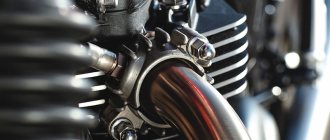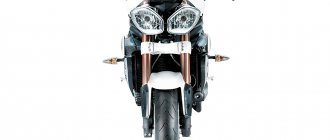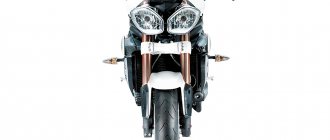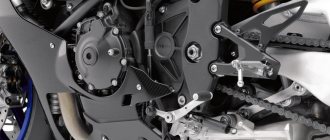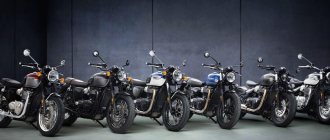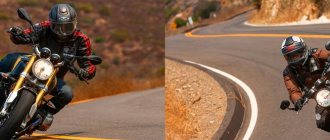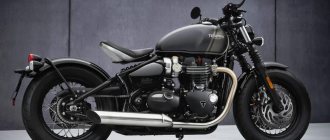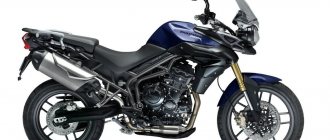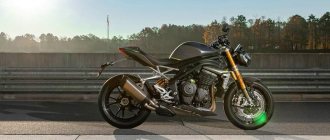Triumph Street Triple RS 2020
In 2021, evil tongues were gossiping that the new Triumph Street Triple RS was not such a Street - that is, a road one - and the manufacturer missed the mark by introducing a track naked bike under the Street guise. However, why “evil”?
Apparently, Triumph knew what it was doing, as the Street Triple RS outsold the base S and the even better-equipped, but more road-ready R. For the 2021 model year, Triumph has updated the Street Triple RS, retaining its track capabilities but giving it back some " road magic.
Triumph Street Triple RS 2021
In the new generation RS, we have retained the best from previous versions and added some good things from R, said the head of Triumph brand management. -It's the character of an R, plus the power of an RS.
How successful were they? My impressions will be below, but for now I will say that Triumph took a balanced, relatively light and very serious road motorcycle, modified it to Euro5 econorms and at the same time improved its character. Plus, they've fixed the only gripe I had with the 2018 Street Triple RS. But first, let's compare what's changed for the 2021 model and what hasn't.
Triumph Street Triple RS 2020
Engine Speed Triple RS 2021-2022
There's a lot to be said about the character of Triumph's threes, and this mighty 1160cc engine is no exception. With 180 horsepower and 125 Nm of thrust, the Speed Triple RS is capable of satisfying the needs of even the most power-hungry rider. The light-squeeze slipper clutch and quickshifter further increase the engine's capabilities: gear shifts are extremely smooth, even when intensively shifting several gears in a row. Like most liter bikes, the Street Triple's gears are on the high side, and on a track with short straights it will most often be in second or third. Fortunately, the Speed Triple's torque curve is wide enough that it can pick up quite well even from relatively low revs.
Motor Triumph Speed Triple RS 2021 and 2022
Triumph talks quite a lot and loudly about the new exhaust system. Thus, about the Speed Triple RS it was said that “this Speed Triple sounds the best ever produced, with a guttural growl of the intake and a distinctive triple howl of the exhaust.” I’m not an audiophile, and I don’t really understand their terms, and as for me, the sound of the RS exhaust cannot be called a “howl,” even though it sounds good. I think a tuned muffler should change that, but with the stock one it sounds literally a couple of notches louder than the “delicate” mark.
What's new in the 2021 Street Triple RS?
Engine
In the previous model, the first two gears were quite high, and everything would be fine, but on a horseback engine it is inconvenient in the city, although quite good for the track. The 2020 Triumph Street Triple RS retains the top traction, but also improves the mid-range and the lower gear ratios have been changed. Triumph also changed the intake port and exhaust camshaft. Thanks to a number of other modifications, it was possible to reduce rotational inertia by 7 percent, and as a result obtain 9 percent higher thrust at 8,000 rpm. Peak thrust is now achieved at a lower rotation speed of 9350 rpm, compared to the previous 10800 rpm. Peak power, according to Triumph chief engineer Stuart Woods, remains unchanged at 121 hp. at 11,750 rpm, exactly 1000 before the cutoff.
We know that in the Street Triple the developers used valve overlap - this means that at a certain moment both the intake and exhaust valves open at the same time, increasing power, but usually here we are talking about top-end power. Valve overlap has been reduced for the 2021 model. In addition to changes to the engine, the model received a new exhaust to increase power at mid-range speeds and comply with Euro5 econorms. The exhaust has a higher flow rate and features dual catalytic converters, but still produces a great sound that Triumph says is even better.
Triumph Street Triple RS 2020
Quickshifter
Another improvement in the new Street Triple RS 2021 is a two-way quickshifter, which is now included in the stock RS configuration. Woods also announced a number of changes to the transmission to improve quickshifter performance. More precise manufacturing of parts made it possible to do without anti-backlash gears in the transmission, and thereby reduce weight.
Why was a quickshifter added to the base version of the Street Triple RS, and not, for example, an inertia measuring device for inclined ABS and traction control? The fact is that this was done at the request of users. According to Perkins, Street Triple buyers want a quickshifter and are much less interested in tilt ABS. Triump is also interested in keeping the price of the Street Triple within certain limits. Sure, the RS isn't a budget model, and that's evident from the components from the brakes to the suspension to the electronics, but Triumph managed to sell more than 90,000 Street Triples by getting the price right, and an inertia-measuring device would push the price beyond the psychological mark.
Design
In addition to the technical changes, the new RS has been subjected to a number of design tweaks, small but effective.
The original Street Triple had round headlights with chrome housings. This decision was inspired by the canons of the “street fighter” class. A street bike was made like this: a beat-up sportbike was taken, cleaned of any remaining plastic, equipped with handlebars instead of clip-ons and some simpler headlights, and the result was a comfortable motorcycle with an upright seating position, urban ergonomics and not weak characteristics of a sportbike. Triumph simply took it and made a similar production motorcycle, eliminating the need for buyers to pound sportbikes and look for spare parts.
However, over time Triumph ditched the round chrome headlights and some people didn't like it. The company has tinkered with the headlights a little more, and the visual changes for the 2021 model are primarily visible at the front—new, more prominent daytime running lights sit on top of the LED headlights. Another interesting change is best seen from the side: the new headlights began to protrude somewhat less from the plastic, and thus a more laconic silhouette of the front end was achieved. Will this help win over the chrome classic headlight crowd? Probably no. But let's hope the grumblers have less reason to grumble.
But enough about the headlights. Let's take a look at the Triumph Street Triple RS 2020 from the other side: aerodynamic through air ducts appeared on the tail section, which have recently come into use on powerful motorcycles such as the Ducati Panigale V4 and Yamaha YZF-R6. Also from the aerodynamic body kit, the RS has a plow at the bottom and a hump on the tail, which can be replaced with a passenger seat if necessary. Also noticeable throughout the bike are changes in the design and finishing of small parts, such as the branded handlebar spacer, heel guards, new shape of the handlebar end mirrors and carbon muffler trim.
The instrument panel in the form of an LCD screen received an optional Bluetooth module, which allows you to connect a phone or GoPro camera to the motorcycle and control it from the dashboard. And with the MyTriumph app, navigation assistance is also available: select your route in the app, and the instrument screen will indicate turning directions using special icons.
The 2021 Street Triple RS will be available in two color options: Silver Ice with red accents, and Matt Jet Black with yellow accents.
What's not new?
The 2021 Street Triple RS is a revision rather than a complete refresh, and much remains the same. And this is good, since the previous model is worthy of all praise. Thus, the chassis and suspension remain the same: 41 mm Showa Big Piston forks, Öhlins STX40 rear monoshock, four-piston Brembo M50 front calipers and single-piston Brembo rear. The radial front brake master cylinder from Brembo has an adjustable handle, and both stroke and force are adjustable, so that the front brake is finely and precisely adjusted.
The 2021 Triumph Street Triple RS still has the same 5 riding modes: Rain, Road, Sports, Track and Custom - the latter, of course, allows you to make all the necessary settings yourself. Rain mode limits power, while in other modes the engine develops full thrust. The modes affect fuel maps, the level of ABS and traction control intervention, but it goes without saying that the same values for some parameters are used in several modes. Traction control can only be disabled in Custom mode, but ABS cannot be disabled at all.
Triumph Street Triple RS 2020
Triumph Street Triple RS road test
Our introduction to the new Triumph Street Triple RS consisted of a drive along the coast through a string of small towns to one good track, where we were given three runs each. Not a lot of time, but what a time it is!
Triumph feels it necessary to point out that the Street Triple is the lightest motorcycle in its class, with a dry weight of 166 kg. Well, it depends on what you consider its class, of course, but in any case, the new product is very light and compact, like all its ancestors. Neutral, natural ergonomics make it comfortable for long rides, and the only thing you want is a little wind protection. The light-squeeze slipper clutch does not tire the hand at all, the brakes are excellent, and after a couple of kilometers I got used to it and felt great. It always takes me some time to get used to and become familiar with a new motorcycle, but in the case of the Street Triple RS it happened almost immediately.
I must say, I have already driven models of the previous generation, but not for long. However, I noticed how much better the mid-range traction was, and having started in Road mode, I very soon decided to check one important point. And switched to Sports.
The fact is that on the previous version the Sports mode was almost useless. It felt like someone had added a handful of caffeine to the gas tank, making the nice bike twitchy and twitchy without adding any power. Driving, making an effort not to twitch is beyond my patience, and since in Road mode the power is exactly the same, I no longer used Sport mode on the previous version.
I was pleased to find that the jerkiness in Sport mode in the new RS was gone. Both modes - Sports and Track - operate on the same fuel map (they differ in the ABS and traction control settings) , and it was gratifying to feel that smooth gas operation is no longer a problem. Woods later told me that the problem here is not so much in the fuel maps, but in modifications to the engine, but this is not so important. More importantly, the new version is free from the most serious drawback of its predecessor. The Sport mode on the current model seemed unnecessary, but on the 2021 version it is perfectly suited for its intended purpose - for spirited solo driving on a twisty road. Road mode is better suited for everyday riding and makes the motorcycle safer.
Triumph Street Triple RS 2021 On the track
After catching on the road we arrived at the track. This is a fairly winding track with some slight elevation changes and only one significant straight section. In short, a great place to evaluate the RS's handling. Most of the lap is done in second or third gear. As a casual couch potato rider, I rarely go to the track, and my results on the Triumph Street Triple RS are unlikely to be much different from those on a typical sportsbike. But there are a couple of issues: the RS's front end rises too easily when I open the throttle, even when I don't want it to, such as when exiting a corner. And, of course, aerodynamics: the absence of a hood and a windshield does not allow you to hide from the oncoming flow. But for a rider like me, these RS features aren't likely to be too limiting. For more serious guys, the inability to turn off ABS may be a problem. I definitely don’t know how to brake better than ABS, but some people can.
The quickshifter works well, but I noticed that at the end of a straight, downshifting when braking before a turn does not work without the clutch. A slight pull on the clutch lever and the gear shifts smoothly. I didn't need the clutch lever for the rest of the lap.
Versatility of the Triumph Speed Triple RS 2021 and 2022
The key to track day success? A well-balanced motorcycle that is easy, fun and not scary to ride, that handles well and allows you to confidently explore the edges of your skills. The stock Speed Triple RS is equipped with high-quality components that allow you to find this very balance in it, customize the motorcycle for yourself and begin to explore your capabilities.
Once in the saddle of the Triumph Speed Triple RS 2021-2022, the first thing I did was adjust the levers. The brake lever has not only an adjustable distance to the grip, but also some modulation of free play. Choose what is closer to you - progressive and smooth brake response or aggressive instant bite and a sharp increase in braking force. The wide handlebars and neutral position of the footpegs are not easily changed, and it took some fiddling to find the optimal riding position for the track. I touched the surface with the footrest a couple of times while leaning deeply, but overall the fit and ergonomics of the Speed Triple are quite suitable for the track. The same goes for the compact chassis, which is more nimble and easier to handle than many 600 and 1000 cc motorcycles that have been ridden on the track.
But the most important tunes for the track are the suspensions, and the 43 Ohlins NIX30 inverted fork and Ohlins TTX36 rear monoshock with remote reservoir are some of the best components available on the market . Both suspensions are equipped with spring preload, rebound and compression adjustments. In the stock setting, the suspensions turned out to be a little soft for the track, which is mainly expressed in sloppy behavior during powerful acceleration when exiting a turn. I tightened both suspensions two clicks in compression and rebound, and this made their work significantly more harmonious and intelligible.
Triumph Speed Triple RS 2021 and 2022 dashboard

